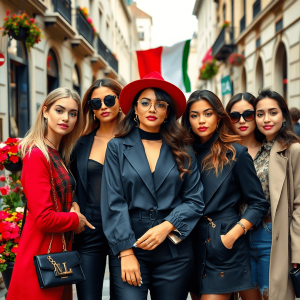How did Italian humanists view the education of women?

April 20, 2025 by Joshua Gonzales
Introduction
The Italian Renaissance was a transformative period in European history, lasting from the 14th to the 17th century. This cultural rebirth brought significant changes to art, literature, and education through the lens of humanism – a philosophical movement that emphasized human potential and classical learning.
Humanist scholars challenged traditional medieval thinking by promoting education as a path to individual growth and societal advancement. Their progressive outlook extended to women’s education, marking a significant departure from medieval restrictions.
Key aspects of humanist views on women’s education:
- Recognition of women’s intellectual capabilities
- Emphasis on moral and literary education
- Support for women’s participation in scholarly discourse
- Belief in education’s role in creating virtuous mothers and wives
The humanist perspective on women’s education emerged against a backdrop of strict patriarchal control. While society largely confined women to domestic roles, humanist thinkers advocated for their intellectual development. This revolutionary stance didn’t seek to overturn social hierarchies but rather to enhance women’s traditional roles through education.
These early champions of women’s education laid groundwork for future generations, recognizing that educated women contributed to family and society’s wellbeing. Their views, though limited by contemporary standards, represented a crucial step toward educational equality.
Historical Context of Women’s Education in Italy
During the Medieval and early Renaissance periods, Italy had strict gender roles that greatly affected women’s education. The prevailing belief at the time was that women should primarily be wives and mothers, which meant their education was limited to skills needed for running a household and religious teachings.
Gender Roles in Traditional Italian Society
In traditional Italian society, formal education was mostly seen as something only men could have. Women were expected to focus on:
- Taking care of the household
- Raising children
- Supporting their husbands
- Upholding family honor
- Practicing their religious beliefs
The male-dominated structure of Italian society created significant obstacles for women seeking education. Male guardians such as fathers, brothers, or husbands had complete control over women’s lives, including whether or not they could learn. This authority extended to:
“A woman should learn in quietness and full submission… I do not permit a woman to teach or to have authority over a man; she must be silent.” – Common religious doctrine of the time
Exclusion from Formal Education
Women were systematically excluded from universities and schools, which were the main institutions for formal education. The only option available for learning was private tutoring, but this was only accessible to wealthy families who could afford it. Even then, the subjects taught to girls were vastly different from those taught to boys:
- Boys studied Latin, Greek, rhetoric, and philosophy
- Girls were instructed in needlework, music, and basic reading skills
- Advanced subjects were deemed unnecessary or potentially harmful for women
- Writing skills were often discouraged as a means to prevent unauthorized communication
This educational inequality not only reinforced existing social hierarchies but also limited women’s involvement in intellectual discussions. It laid the groundwork for later challenges to these established norms during the humanist movement.
Humanist Perspectives on Education and Women
The studia humanitatis was an innovative educational framework created by Italian humanists. It focused on studying classical texts to enhance both intellectual abilities and moral character. The program included five main subjects:
- Grammar and philology
- Rhetoric and composition
- Poetry and literature
- Moral philosophy
- Ancient history
Humanist educators believed that these subjects could instill virtue in women by exposing them to classical role models. In his work De studiis et litteris, Leonardo Bruni argued that women should study Latin literature to gain moral wisdom and eloquence.
Emphasis on Moral Instruction
The primary focus of education for women during this time was on moral teaching rather than preparing them for specific professions. Humanists encouraged women to read works by:
- Cicero for understanding moral philosophy
- Virgil for appreciating poetry
- Christian texts for spiritual guidance
This selective approach aimed to shape virtuous wives and mothers while still upholding social boundaries.
Private Study Over Public Discourse
Unlike their male counterparts, female students were discouraged from participating in public discussions or debates. Instead, their education emphasized developing personal virtue through solitary reading and introspection.
The humanist curriculum for women represented a careful balance between promoting intellectual growth and conforming to societal expectations regarding gender roles. While it opened doors for women to access classical knowledge, educators intentionally chose content that aligned with prevailing notions of femininity.
Notable Humanist Figures Advocating for Women’s Education
Two remarkable female humanists emerged during the Italian Renaissance, challenging societal norms through their intellectual prowess and advocacy for women’s education.
Isotta Nogarola (1418-1466)
Isotta Nogarola transformed her family’s Verona palace into a center of humanist learning. Her dedication to scholarly pursuits led her to exchange letters with prominent intellectuals across Italy. Nogarola’s most influential work, Dialogue on Adam and Eve, presented a revolutionary defense of Eve’s actions in Paradise, arguing that women’s intellectual capabilities matched those of men.
Laura Cereta (1469-1499)
Laura Cereta wrote passionate defenses of women’s right to education in her letters and treatises. Born in Brescia to a physician father who supported her studies, she learned Latin by age eight and became proficient in mathematics and astrology. Her famous work Defense of the Liberal Instruction of Women challenged critics who claimed educated women were “unnatural”:
“Why shouldn’t the mind of women be considered apt for studies? […] Nature has granted to all the capacity to learn.”
These pioneering women faced significant backlash from male scholars. Nogarola retreated from public life after harsh criticism of her work, while Cereta’s writings were dismissed as mere imitations of male authors. Their experiences highlighted the deep-rooted resistance to women’s intellectual advancement in Renaissance society.
Both scholars left behind extensive collections of letters and philosophical works that documented their struggles and achievements as educated women in a male-dominated intellectual sphere.
Varied Educational Opportunities for Women in Renaissance Italy
Educational access in Renaissance Italy reflected stark social hierarchies, with noble women enjoying privileged learning opportunities unavailable to their lower-class counterparts. Women from patrician backgrounds received instruction within domestic settings, often through private tutors who taught reading, writing, and basic arithmetic.
Common Educational Spaces for Noble Women:
- Private family libraries
- Domestic chapels
- Personal chambers dedicated to study
- Convents affiliated with wealthy families
The quality and depth of education varied significantly based on family wealth and social connections. Daughters of merchants and aristocrats might learn:
- Classical Latin texts
- Religious writings
- Basic musical instruction
- Household management skills
- Letter writing and correspondence
Noble families often arranged for their daughters to study under renowned humanist scholars, though these arrangements remained informal and limited compared to male education. Some wealthy households maintained small study groups where young women could gather for collective learning sessions.
The physical spaces for women’s education remained strictly controlled. While sons attended universities and formal schools, daughters studied within carefully monitored domestic environments. This spatial restriction reinforced social expectations about women’s roles while still allowing limited intellectual development.
Convents served as significant educational centers for women from affluent families. These institutions provided structured learning environments where women could engage with religious texts and receive basic instruction in Latin, though the curriculum remained carefully curated to maintain appropriate gender roles.
Resistance to Women’s Education: Conservative Groups and Societal Norms
During the Renaissance in Italy, there were many people who strongly opposed women’s education. These conservative groups saw female learning as a danger to the stability of society. Religious leaders and traditionalists believed that if women became educated, they would:
- Ignore their responsibilities at home
- Challenge the authority of men
- Become morally corrupt
- Upset the natural order of society
One example of this resistance is Dominican friar Giovanni Dominici, who wrote a book called “On the Education of Children” in 1405. In it, he warned that teaching women how to read could result in them sending secret messages to their lovers. Instead, he argued that women’s education should be limited to practical skills for running a household and religious teachings.
Conservative nobles also feared that educated women would question the power of men within their families. A significant instance of this can be seen in Venice, where the Council of Ten enacted laws in 1421 to restrict women’s access to Latin education. They justified this decision by claiming it would lead to moral decline.
This opposition to women’s education was not just a local phenomenon but part of a broader trend across Europe. In fact, similar restrictions were imposed in other regions as well, reflecting a widespread fear among conservative groups about the implications of women’s education on societal norms and family structures. The influence of humanist thinkers like Leonardo Bruni further complicated these dynamics. His work “De studiis et litteris,” published in 1424, suggested that women should concentrate on studying religious texts and avoid subjects such as rhetoric and mathematics, which were considered masculine pursuits.
The opposition to women’s education was evident in various ways:
- Girls were taken out of schools when they reached puberty.
- Women’s written works were destroyed.
- Educated women were publicly mocked.
- Access to libraries and scholarly resources was limited.
Tension Between Progressive Humanist Ideals and Traditional Norms
The clash between humanist educational ideals and societal realities created a complex landscape for women’s education in Renaissance Italy. Humanist scholars advocated for women’s intellectual development while simultaneously reinforcing traditional gender roles – a paradox that shaped educational opportunities for women.
This tension manifested in several ways:
-
Limited Curriculum Scope: While humanists supported women’s education, they often restricted the subjects women could study. Classical languages and literature were acceptable, but philosophy and rhetoric remained largely off-limits.
-
Domestic Focus: Educational programs for women emphasized skills that enhanced their roles as wives and mothers rather than pursuing knowledge for its own sake.
-
Public vs. Private Learning: Women’s education was confined to private spaces, contrasting with men’s access to public universities and formal institutions.
The writings of female humanists reflect this struggle:
“I have chosen the life of the mind…yet I am compelled to prove that my intellectual pursuits do not diminish my feminine virtues.” – Laura Cereta
These contradictions created a unique educational model where women gained access to learning while still operating within strict social boundaries. Some families embraced humanist ideals by educating their daughters, yet maintained strict control over how this education was applied in practice.
The disparity between progressive educational theory and conservative social practices resulted in partial reforms that allowed limited intellectual advancement while preserving existing power structures.
Legacy of Humanism on Modern Views About Women’s Education
The progressive ideals of Italian humanists laid crucial groundwork for modern educational equality. Their revolutionary stance that women deserved intellectual development challenged centuries of exclusion, creating ripples that influenced subsequent educational reforms.
These early advocates sparked essential conversations about women’s intellectual capabilities – debates that continue to shape educational policies today. The humanist emphasis on moral and intellectual development for both genders established a foundation for:
- Universal access to education
- Recognition of women’s academic potential
- Integration of women into scholarly discourse
- Equal opportunities in higher learning
Yet the work remains unfinished. Modern statistics reveal persistent gender gaps in STEM fields, leadership positions, and academic recognition. The humanist vision of educational equality calls for renewed commitment to:
- Eliminating gender bias in curriculum design
- Supporting women in male-dominated fields
- Providing equal resources and opportunities
- Challenging lingering stereotypes about women’s academic abilities
The Italian humanists’ bold vision for women’s education still inspires today’s efforts to achieve true educational equality. Their legacy reminds us: the pursuit of knowledge knows no gender.
FAQs (Frequently Asked Questions)
How did Italian humanists contribute to the education of women during the Renaissance?
Italian humanists played a crucial role in advocating for women’s education by recognizing its importance for societal improvement. Despite existing patriarchal norms, they argued that educating women was essential for moral and intellectual development.
What were the traditional views on women’s roles in education during the Renaissance in Italy?
Traditional views during the Renaissance often confined women to domestic roles, severely limiting their access to formal education. Patriarchal structures dominated society, leading to widespread exclusion of women from academic opportunities.
What is studia humanitatis and how did it relate to women’s education?
Studia humanitatis refers to a curriculum established by humanists focusing on subjects like grammar, rhetoric, and history. While it aimed at fostering moral virtues, its application to women’s education was limited and often prioritized moral instruction over comprehensive learning.
Who were Isotta Nogarola and Laura Cereta, and what did they advocate for?
Isotta Nogarola and Laura Cereta were notable female humanists who championed women’s right to education. Their writings argued for the importance of educating women, highlighting their intellectual capabilities and contributions to society.
What educational opportunities existed for women from different social classes in Renaissance Italy?
Educational opportunities varied significantly based on social class. Noblewomen often had more resources for informal learning but still faced restrictions. Wealthy families sometimes provided private instruction, allowing girls access to education outside formal schooling.
What resistance did proponents of women’s education face during the Renaissance?
Proponents of women’s education encountered significant resistance from conservative factions who feared that educating women would disrupt traditional gender roles. This societal pushback highlighted the tension between progressive humanist ideals and entrenched patriarchal values.
Written by
Joshua Gonzales
You may also interested in:

Do Italian women drink wine when pregnant?
Explore the cultural norms and health risks of wine consumption during pregnancy among Italian women. Balance tradition with safety.
What features do Italian women have?
Explore the allure of Italian women: their unique features, fashion sense, personality traits, and deep cultural connections.